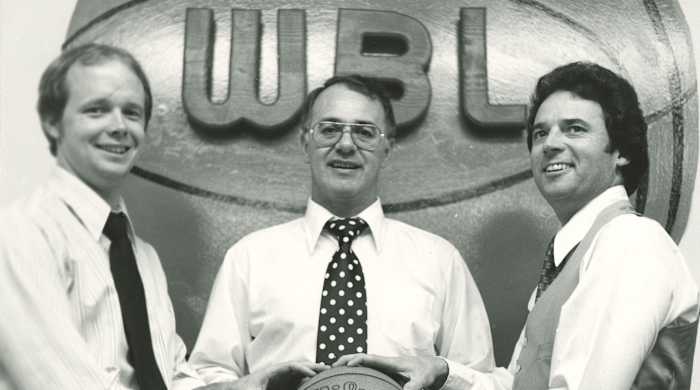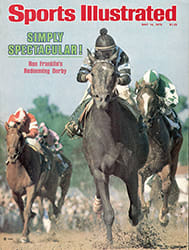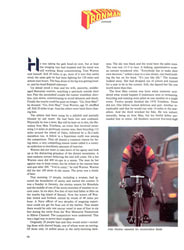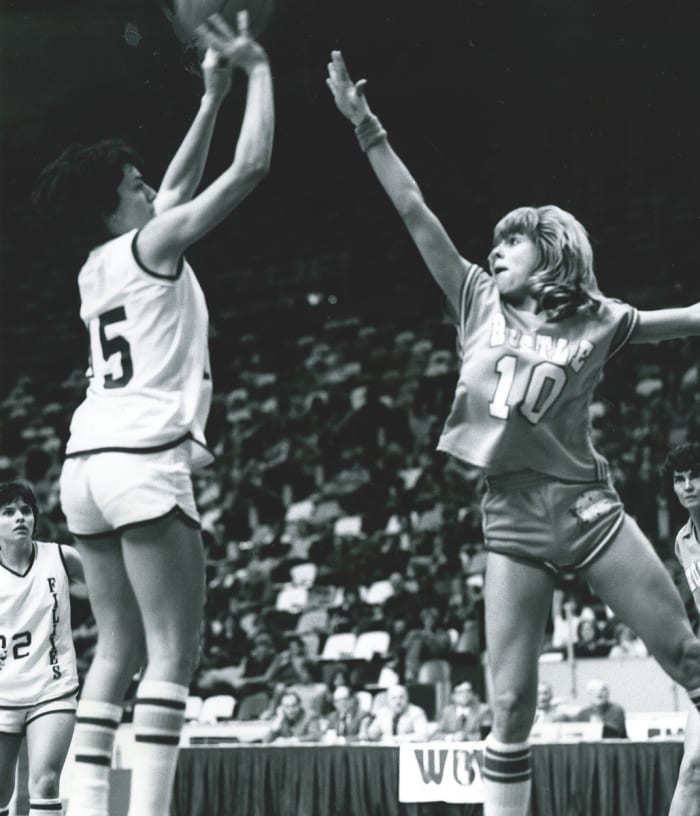Red Ink, Rosy Future
After observing his first game of women's pro basketball, a distinguished critic made the following observation: "When they're not running, they're jumping. When they're not jumping, they're diving. When they're not diving, they're shooting. When they're not shooting, they're passing. These girls can really operate." The speaker was a man who can also operate, one Julius Erving.
Last week, in the fifth and deciding game of the first Women's Professional Basketball League championship, the Houston Angels ran, jumped, dived and shot their way to victory over the Iowa Cornets, 111–104, before 5,976 fans at Houston's Hofheinz Pavilion. Houston Forward Paula Mayo, who at 5'11" and 185 pounds is affectionately called "Moose" by her teammates, contributed a game-high 36 points and 22 rebounds, but it was a tenacious defense and a total team effort, concepts preached by Coach Don Knodel, that won for the Angels.
After the game, at a party hosted by Bill Byrne, the WBL founder and president, there was a sense of relief, pride and joy. Economic pressures had not forced the eight-team league—Houston, New York Stars, New Jersey Gems and Dayton Rockettes in the Eastern Division and Iowa, Chicago Hustle, Minnesota Fillies and Milwaukee Does in the Midwest—into an early grave, as many had predicted. The WBL finished its 34-game regular season and championship series with player salaries, arena rentals and travel expenses paid. To be sure, all eight teams lost money. Chicago, which had a $150,000 deficit, came closest to breaking even. Milwaukee suffered the most—some $325,000 worth—while the other clubs lost an average of $260,000.
"It's hard to be excited when you've lost money," said Minnesota President Gordon Nevers, a great-nephew of Ernie Nevers, "but we have proved that we are credible. Now we have to market our product. We had only 45 days to prepare this year, but now we will have eight months. I had hoped to average 3,000 fans, but we ended up with only 1,500 and even that was not all paid.
"For our last game in Minnesota we drew 2,600, and I'm convinced we can sell 2,000 season tickets next year. The league has a three-year plan. It doesn't expect to break even until after the 1980–81 season, but Minnesota is going to break even next year."
Heady talk, perhaps. Although the Cornets play in a hotbed of women's basketball (the Iowa girls' state high school tournament draws sellout crowds of 15,000), they project three years of red ink, totaling $405,500. Houston's president and general manager, Hugh Sweeney, who is a promoter for the Avon tennis tour, also foresees a struggle.
"This has been a pioneer year," said the 6'6" former amateur tennis player. "We proved to the press that we're for real, but now we have to prove it to the public. It may take two or three years, but it took women's tennis a lot longer than that. The payroll is what kills you in pro sports today, but WBL salaries are low [$5,000 to $15,000, compared to the NBA average of $143,000]. I have most of my girls signed to three-year contracts, and I'm certain that we're going to make it." Asked what it was like to win the first WBL championship, Sweeney pulled on his cigar and replied, "It's kind of like being in the first covered wagon to cross the country."
For the players, the pioneers in kneepads, the season had indeed offered similarities to frontier roughing it. They had endured blizzards, tornadoes and torrential rains, including the Houston Flood that forced postponement of the second game in the championship series.
"The first year has been a great experience, but not everything has been a bed of roses," says Iowa Guard Tanya Crevier. "The travel was the worst, and some of the facilities were atrocious. We usually changed and showered in our motel rooms. In some lockers the floors hadn't been swept for weeks, paint was peeling off the walls and bugs were crawling all over the shower-room floors. In our first year we can't expect the greatest, but it would be nice to take a shower without worrying about athlete's foot."
This season the Cornets played in eight Iowa "hometowns," and to travel to their games, owner George Nissen, the largest manufacturer of gymnastics equipment in the world, purchased a $31,200 Greyhound bus, dubbed the Corn Dog. The green and gold Corn Dog is equipped with two TV sets, a stereo system, a refrigerator, three game tables, chairs that open up into beds, and floor-to-ceiling carpeting. Luxurious though the Corn Dog is, travel could be horrendous. In January, after beating Chicago in Cedar Falls, the team had to follow a snowplow to Des Moines for its afternoon game against Minnesota. A trip that normally takes two hours lasted six, and en route the sweaty Cornet uniforms, stashed in a luggage compartment under the bus, froze. With no time to pick up fresh uniforms, the players thawed out their dirty ones, then stepped onto the court and lost to the Fillies, 109–107.
"For many of us the WBL has been a step down from college ball," says Iowa Forward Nancy Rutter, a former star at the University of Missouri. "In college we had weight rooms, a training table and super facilities, but this is the WBL's first season. We can't expect everything to happen overnight. It didn't at Missouri either. My freshman year [1974–75] we didn't have scholarships, there wasn't even a locker room for the team and we didn't play any games out of state."
Asked if they thought the league would make it, 12 Cornets nodded their heads in unison. Center Doris Draving said, "All you have to do is see a game in Chicago. The excitement in that gym is enough reason to believe the league will survive."
As noted, Chicago, the fourth team to join the league after Iowa, New Jersey and Milwaukee, was the WBL's most successful franchise. The Hustle averaged 2,122 fans, second to Iowa's 2,332, but the average was lowered by two games in which the Blizzard of '79 reduced the crowds to fewer than 600. In its last six home games, with the snow melted, the Hustle averaged 3,105.
The key to the team's success was a TV contract with WGN, the country's largest independent station, which on Dec. 14 televised Chicago's first home game. "It gave us instant exposure," says Chicago G. M. Chuck Shriver. "The viewers saw that women could play basketball. It wasn't the slow powder-puff game they expected." WGN, surprised at ratings twice as high as forecast, bought the rights to nine more games and came up with a winner. Hustle telecasts attracted nearly 140,000 viewers a game. Chicago Black Hawk games averaged fewer than 60,000 viewers. With a crowd-pleasing run-and-gun game, the Hustle led the WBL in scoring (111 points per game) and featured the league's best all-round player, Guard Rita Easterling, an All-America at Mississippi College.
Television may have increased fan interest, but credit must also be given to the promotional wizardry of Shriver, who brought 13 years of major league experience, including three years with the White Sox, to the WBL. "I learned a great deal about operating a franchise by observing Bill Veeck," said Shriver. "That man could produce a record crowd to watch a paint-drying contest."
Using Veeck's philosophy—you can't guarantee a win, so always provide an evening's entertainment—Shriver hired the Sox' and Bulls' organist, Nancy Faust, and staged a number of giveaway nights. At midseason, the team also began handing out free Dr Peppers every time the Hustle surpassed 110 points, which it did 10 times in its remaining 18 games. A fan room was set up at DePaul University, where the Hustle played, and after games the players mixed with the spectators. The women also appeared on talk shows, and at company outings and school programs. La-Z-Boy hired Easterling as its Chicago representative (there is talk she will replace Joe Namath as the company's national rep as well), and other players are now receiving $400 fees for guest appearances. As for next year, the Hustle's opening game is already sold out—that's a crowd of 5,200—season-ticket requests are coming in and WGN has again agreed to purchase the rights to televise Hustle games.
Inspired by Chicago's progress, the other teams are racing to catch up. Milwaukee, which some claim was mismanaged from the outset, has fired part of its front-office staff and is rumored to be interested in hiring Larry Costello as coach. New York owner Ed Reisdorf is moving the Stars to New York City proper and hopes to play in Madison Square Garden. This past season, playing in New Rochelle, a New York City suburb, the Stars were the best-kept secret in sport. Mizlou, the independent network that packaged Cosmos games for three years, is negotiating to televise some Star home and away games, and WOR-TV has cleared air time for Star home games on Saturday afternoons. Pro-Keds will also feature a Star or two on its billboards and subway posters, more than likely twins Kaye and Faye Young from N.C. State, along with 76er Center Darryl Dawkins. Reisdorf is naturally encouraged. "Even the Garden people have no cynicism about the viability of the league," he says.
Having survived its "credibility year," the WBL will expand to 14, possibly 16, teams next season. All the original eight teams will be back, but Dayton, which needed more than $96,000 from the league to pay its bills, has been sold to a Washington, D.C. group. Dallas, St. Louis, San Francisco, Boston and Los Angeles have been awarded franchises for a $100,000 membership fee, twice what it was last year, and although Dallas has as yet no players, it has already landed a TV contract. Denver, Portland, Seattle, Philadelphia and Atlanta are the other cities being considered by the WBL. Founder Byrne says, "We will definitely be coast-to-coast, the league will be divided into three divisions—East, Midwest and West—all clubs will have some form of television [only four had TV this year], and a national TV Game of the Week is a strong possibility."
This season, with all its teams located east of the Rockies, the WBL couldn't get national advertising or expect a network contract. Now, with 100% of the major markets to be tapped, the latter is a distinct possibility. According to Byrne, the new owners have "heavy money" and they are willing to spend and more than likely lose, tax write-offs aside, $400,000 per team next year. Top college players Ann Meyers, Lucy Harris and Carol Blazejowski are holding out to play in the 1980 Olympics, but the WBL is building its own stars. Easterling, Mayo and Iowa's Denise Sharps could hold their own against their more famous sisters.
"No sports league has ever made money in its first season," says Bill Byrne. "At the beginning of the year all we heard was, 'Do you think the WBL is really going to make it?' Now the question is, 'Where to next?' "



